
"Paris" © 2009 Lizzy Stewart. All rights reserved.
Bonjour! Comment ça va?
J'ai faim -- quelle surprise!
Picture Books about France, Part One, with a few punitions, satisfied my hunger for a leetle while. But now, I am in the mood for my morning cup of Darjeeling, a warm croissant, and more stories set in the land of pâtisseries, artistes and les animaux!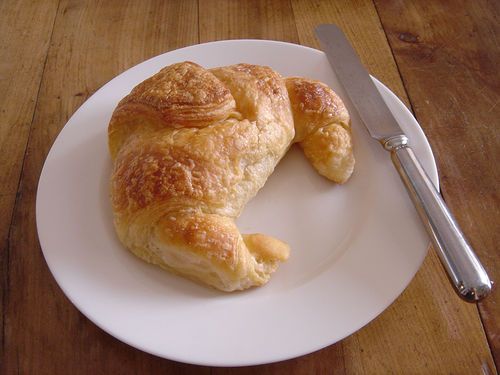
photo by timmertaugh.
C'est vrai. In my quest to find the best picture books with a French setting, many included dogs and cats. Remember Bonaparte, Metro Cat and Zaza the dachshund? In this second batch, we have three cats as main characters. Does this mean the French have an inordinate love for les chats -- or is there something innately "French" about cats that make them ideal for these particular types of stories? Perhaps authors who like writing about France just happen to also be cat lovers. I haven't been to Paris in years, but I sense there are a lot of stray cats wandering around the city. Oh well, Marie Antoinette has her loyal pug, Sébastien, so that evens things up a bit. ☺
On this lazy summer day, I'm quite happy to share my croissant with you. I'll break it in two (see those crisp brown flakes scattering?). Lovely how the dough pulls apart just so, and when you bite into it, there's that gentle crunch before the divine butter rush. Have fun sharing these books with the short people in your life (you can keep your half of the croissant all to yourself). Bonne Journée!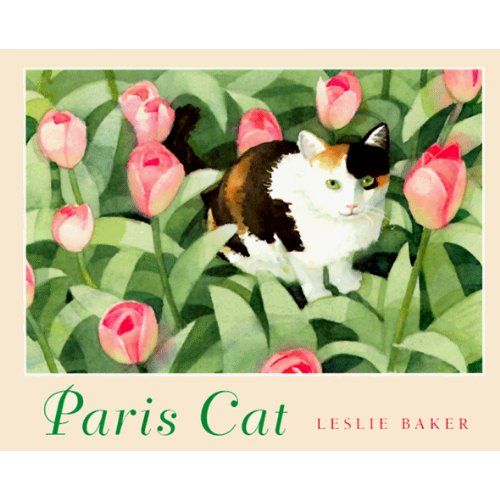
PARIS CAT by Leslie Baker (Little, Brown, 1999). If you ask Alice the calico cat, Paris is full of dogs. On her first visit to the splendid city, she spots a mouse, and can't resist chasing after it, despite Annie trying to call her back. So, it's dart this way and that, scamper and scurry down one street after another, past shops, through an outdoor market ("Mmmmmm . . . cheese . . . sausages . . . fish"), down the banks of the Seine. The mouse is soon forgotten when Alice's fun is foiled by dogs dogs dogs everywhere. To escape, it's in and out of the Louvre, off a bridge!, tumbling onto a bateau-mouche. Now Alice is exhausted. How will she ever find Annie? Such a lively tail, accompanied by lovely soft-edge watercolor illos. A catnap completes this purry fine cat's eye view of Paree. ☺
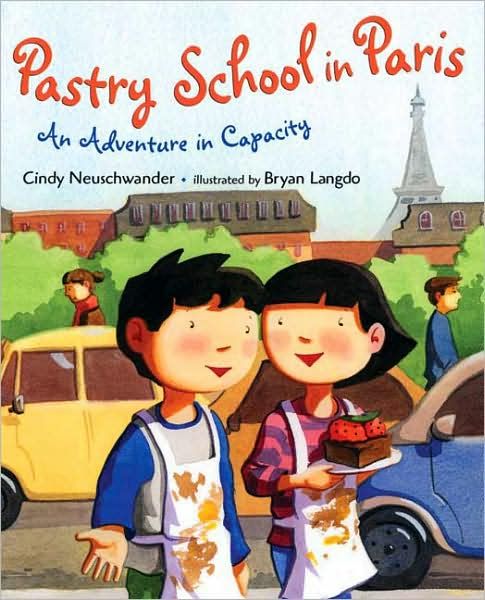
PASTRY SCHOOL IN PARIS: An Adventure in Capacity by Cindy Neuschwander, pictures by Bryan Langdo (Henry Holt, 2009). What better way to learn about math than by whipping up something delicious? Because twins Matt and Bibi show real baking talent with their brownies, their parents d
Viewing: Blog Posts Tagged with: thematic book lists, Most Recent at Top [Help]
Results 1 - 16 of 16
Blog: jama rattigan's alphabet soup (Login to Add to MyJacketFlap)
JacketFlap tags: thematic book lists, french books, summer soup 2010, Add a tag
Blog: jama rattigan's alphabet soup (Login to Add to MyJacketFlap)
JacketFlap tags: thematic book lists, french books, summer soup 2010, Add a tag
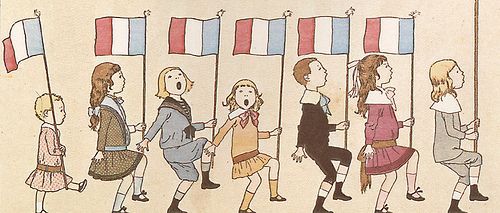
from Chansons de France Pour Les Petits Français by M.B. de Monvel (1979), source: moonflygirl.
Bonjour, mes enfants!
Have you been good or bad this summer? Pretending to be good, but maybe a little naughty on the side?
C'est d'accord. You will probably like your punishment: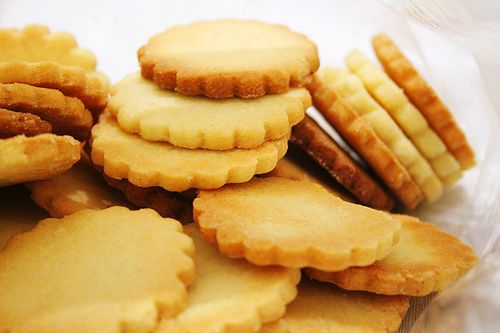
photo by roboppy.
Oui, a handful of la punitions, those famous butter cookies from the Poilâne Bakery in Paris! Pierre Poilâne's grandmother used to play a game with her grandchildren. She called them over to seemingly punish them, but offered a handful of these cookies instead. Today, if you visit any of the Poilâne bakeries, you will find a basket of free punitions by the register. Trés délicieux!
To go with your cookies today, how about a few picture books set in Paris? It's the best way to visit from the comfort of your window seat, hammock, or porch swing. There are funny animals, rollicking adventures, a few artistes, even some crêpes. If you've never been to Paris, you will experience the joie de vivre of this great city and see some of its most famous landmarks. And if you've already visited La Ville-Lumière ("The City of Light"), these stories will touch your heart and make you yearn to go back again. 
Paris panorama by Benh Lieu Song (click to enlarge).
Today, we are all honorary Parisiens -- so let's put on our bérets and striped shirts. It's a lovely day on the Left Bank!
LA LA ROSE by Satomi Ichikawa (Philomel, 2004). Our first stop, Luxembourg Gardens. La La Rose the pink rabbit tells about the time she went there with her little girl, Clementine, and got lost. Things were fine at first. Clementine and her brother Pierre had a lot of fun at the playground and carousel. But when Grandma rushes them over to see the puppet show, La La Rose falls out of Clementine's backpack. Oh no!
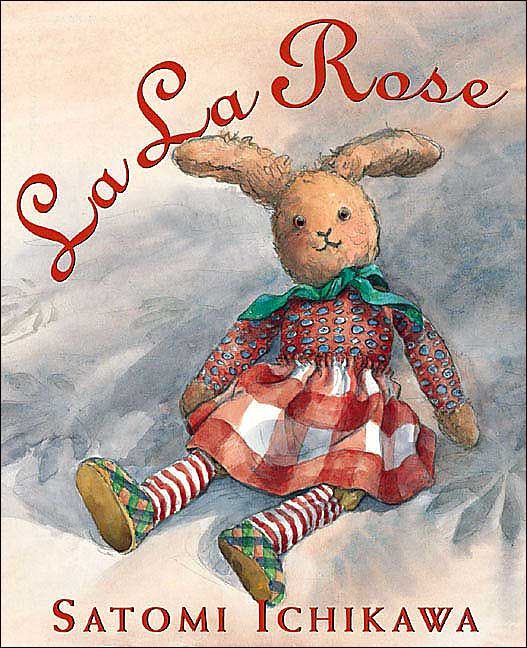
She has some rather unpleasant "adventures" as a result: tossed into a trash can, tumbling down stairs, thrown high into the air and dragged from the fountain by a dog. Will she ever be reunited with her beloved Clementine? With a simple narrative and dreamy watercolor spreads, Ichikawa captures the special bond between a child and her favorite stuffed animal, while giving us a peek at the beautiful gardens she clearly loves (layout of LG on the endpapers).
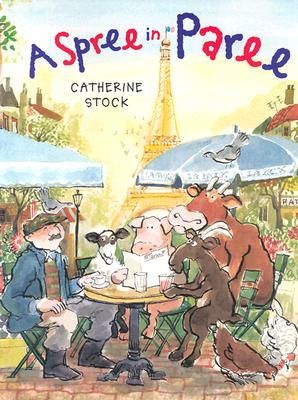
<
Blog: jama rattigan's alphabet soup (Login to Add to MyJacketFlap)
JacketFlap tags: thematic book lists, asian pacific american heritage month, Add a tag
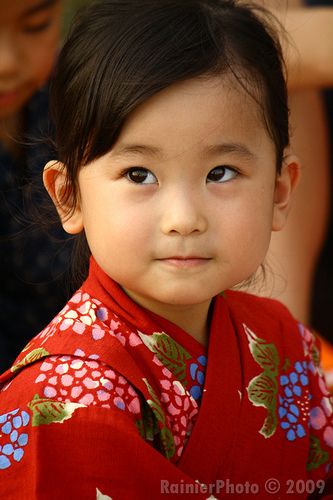
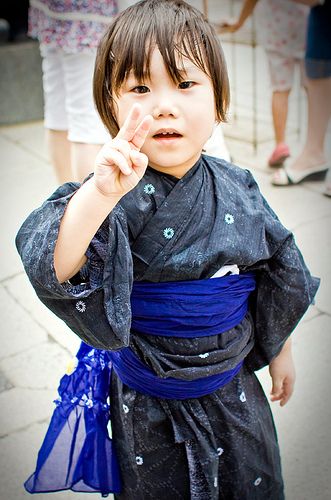
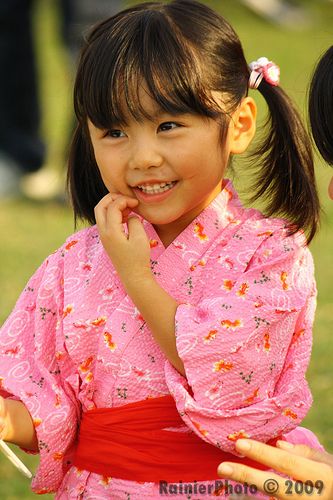
photos by *Randee and sir_mencius.
Konnichiwa! Ogenki desu ka?
Ready to spend a little time in the Land of the Rising Sun? Perhaps you wouldn't be adverse to a savory, artfully arranged dinner box containing salmon teriyaki, shrimp and vegetable tempura, tsukemono, negamaki, seaweed salad, and several slices of maki-zushi. Oh, and miso soup, of course! What's that? You're pressed for time? Well, what about a nice bowl of ramen or a cute little bento box?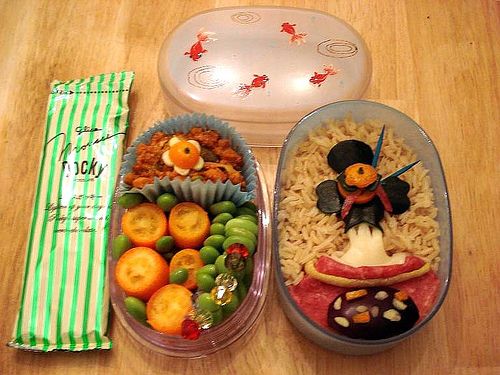
Geisha bento by Sakurako Kitsa.
I was happy to find a few more Japan-related picture books. Today's menu includes kite flying, origami, ghosts and historical fiction. When you're done slurping your noodles, dip into these fine titles!
Enjoy your meal!
Douzo Meshiagare!
BUTTERFLIES FOR KIRI by Cathryn Falwell (Lee & Low, 2003). Kiri, who loves to draw, paint and make things, receives a colorful origami set with an instruction book for her birthday. She eagerly tries to make a purple butterfly, just like the one her aunt placed on her birthday gift, but after a couple of folds, she accidentally tears the paper. Disappointed and frustrated, she decides to practice using plain notebook paper, but after a few more folds, the same thing happens. She continues to practice without success, until one Spring day, she's inspired to paint a picture of the pretty flowers she sees in the park. Things are fine until her paint smears. After she dries her tears of frustration, she comes up with a creative solution to finish her painting by cutting shapes from her origami papers. And the finishing touch? A beautifully folded yellow butterfly! Bright, colorful, cut and torn paper collages nicely complement this satisfying story celebrating art, determination and mastering a new skill. Includes instructions for folding an origami butterfly.

GHOSTS FOR BREAKFAST by Stanley Todd Terasaki, pictures by Shelly Shinjo (Lee & Low, 2002). One night, the Troublesome Triplets, who are always together and known for their constant worry and complaints, pound on the young narrator's door with frantic reports of ghosts in Farmer Tanaka's field. Mr. Omi, Mr. Omaye and Mr. Ono wring their hands as they describe the terrible long, thin, white apparitions "dancing
Blog: jama rattigan's alphabet soup (Login to Add to MyJacketFlap)
JacketFlap tags: asian pacific american heritage month, thematic book lists, Add a tag

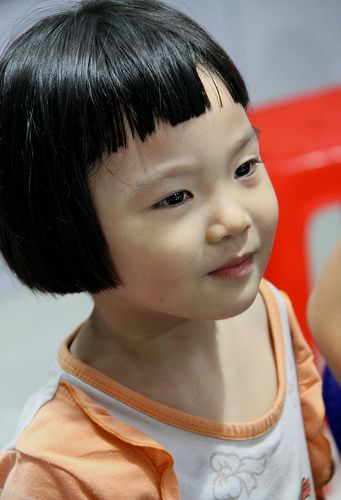
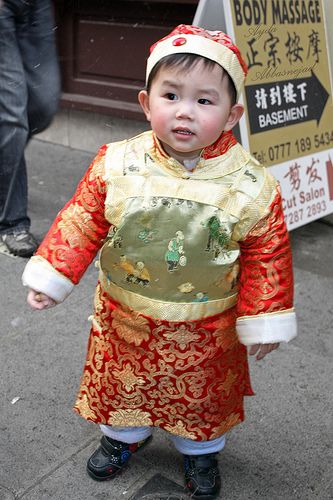
photos by liveline, lionel bodilis, and Ayda7.
So, last time I featured some picture books about Korean culture and joyfully gobbled up a full platter of Jap Chae with Bulgogi. Turnip and won bok kimchee, fishcake, beansprout and watercress namul, lotus root and cinnamon tea perfectly topped off the meal. I must admit -- I don't usually limit such lipsmacking goodness to the month of May, but since it's Asian-Pacific American Heritage Month, I have good reason to whet your appetite to the max so you can celebrate heartily with good books and good food.
Just as Chinese restaurants are ubiquitous in this country, there has never been a shortage of China-related books for any age group. Every major city has a Chinatown, but not necessarily a Korea-town or a Japan-town. For quite awhile, I had to "pretend" I was Chinese in an attempt to identify with the sought-after element of Asian-ness I craved in books. So I encountered Laurence Yep, Betty Bao Lord, and Maxine Hong Kingston before I discovered Yoshiko Uchida, Lensey Namioka, Cynthia Kadohata or Linda Sue Park.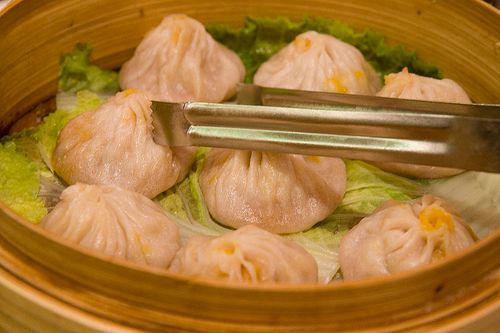
Soup dumplings photo by stynxno.
There are many more China-related picture books I want to read. I'm rounding up some of my recent finds in today's post, and then I'll feature several Japan-related books in Part 3. I can just imagine biting into a warm soup dumpling, the happy talky talk in a busy dim sum restaurant, the sizzle and crackle of hot oil in a wok beckoning sliced onion, green beans, carrots and pork. Today's menu includes a ghost story, a gorgeous visual poem, and a family adjusting to life in America. Should we eat and then read, or read and then eat?
Why don't we just dig in?
BOY DUMPLINGS by Ying Chang Compestine, pictures by James Yamasaki (Holiday House, 2009). Yum! Take one hungry Garbage-Eating ghost, a plump and juicy boy, an outrageous recipe for 1000 dumplings, and you've got just the right ingredients for a hilarious trickster tale. One night in Beijing, a skinny ghost roaming the streets discovers the buckets containing his usual food offerings are empty. After three days without food, he becomes desperate, grabs a chubby lantern-carrying boy and takes him home. But before the ghost has a chance to eat him, the impish boy tempts him with a delicious recipe for boy dumplings, which he simply cannot resist.

Extremely gullible and growing hungrier by the second, the ghost traipses through the village gathering the outlandish ingredients (10 pounds stinky garlic, 50 pounds rotten onions, 40 pounds wormy cabbage, 1 large bottle soy sauce, 1000 moldy dumpling w
Blog: jama rattigan's alphabet soup (Login to Add to MyJacketFlap)
JacketFlap tags: thematic book lists, cupcakes and bake shop treats, Add a tag
THE STORY OF CHERRY THE PIG by Utako Yamada (Kane/Miller, 2007). Sweet story of a dessert-loving pig who enters a bake-off after overhearing several mice raving about her apple cake. All seems to be going well at the Harvest Festival, as Cherry whips butter, chops apples, and mixes spices for her recipe until she hears the same mice making fun of her and calling her cake "incredibly awful." She's crushed, but later learns she has won first prize: the Gold Whisk! So why did the mice say those mean things when everyone else loves her cake? A charming tale about the power of perception -- what's good for some, is awful for others. Cherry opens a bakery, and finds a way to please the mice!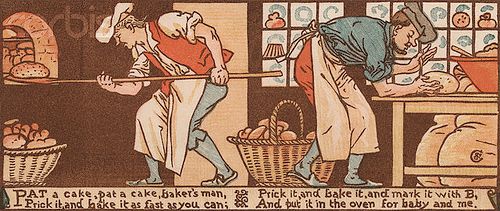
I've been patting a few cakes all month long, and having a jolly good time visiting and reading about some of the people who create breads, cookies, cupcakes, pies, and many other favorite treats. More, more, more, I say! Bring on the flour and the dough and the rolling pins. Bring on the batter bowls, pastry tubes, sprinkles and pink icing!
The oven may be hot, but there's nothing like the warmth emanating from the heart of a baker. In kids' books, traditionally bakers are portrayed as rotund, benevolent souls. This is true for most of the picture books featured in this post, but I was happy to discover they are also characterized by other admirable qualities: a heroic baker who's an ingenious nonconformist, one who pours her love into a special bread and sets off a chain of contentment, another who displays kindness and compassion to a stray animal, one who learns to see things from a different point of view, and yet another who learns the lesson of generosity and "invents" the baker's dozen.
Hope you enjoy and share these gems with your favorite munchkins, and while you're at it, why not bake a batch of cookies, a loaf of bread, or make a bakery run for a couple of cupcakes? ♥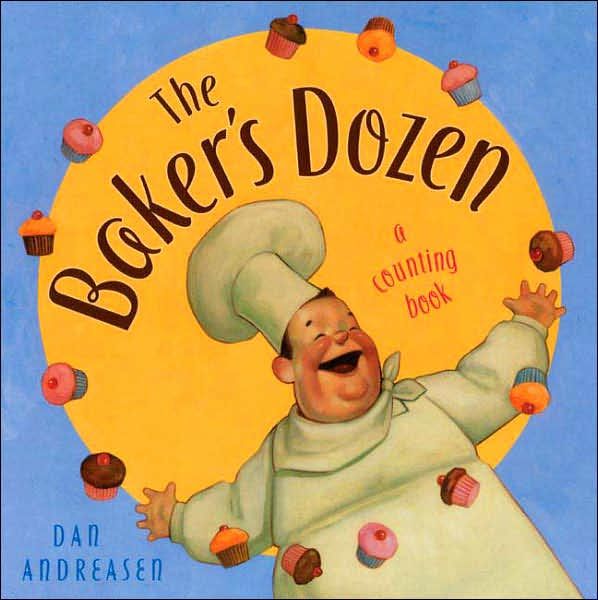
THE BAKER'S DOZEN: A Counting Book by Dan Andreasen (Henry Holt, 2007). A jolly, red-cheeked, roly poly baker serves up a bounty of heavenly sweets from 1-12 in this rhyming counting book. His joy is contagious, and Andreasen's retro-style oil paintings capture every bit of the baker's glee as he "takes great care to make one cream éclair," "bakes two German chocolate cakes," and "in tins the perfect size he bakes three cherry pies." He balances pies on his fingers and toes, draws doodles on top of strudels, juggles cupcakes, and then greets 13 lucky customers at the door. Cherry Pie lover Andreasen tops off this visual feast with a number graph displaying the complete menu of delectables. Nom to the nth power.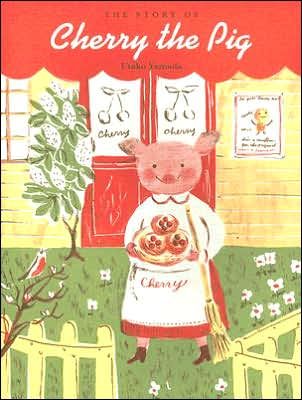
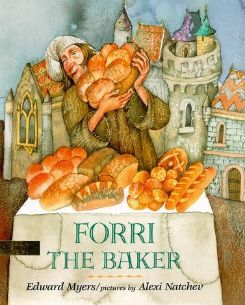
FORRI THE BAKER by Edward Myers, pictures by Alexi Natchev (Dial, 1995). One of the few thin bakers in picture book history, Forri is known far and wide for his incredible variety of breads -- root bread,
Blog: jama rattigan's alphabet soup (Login to Add to MyJacketFlap)
JacketFlap tags: thematic book lists, pajama party, soup month, Add a tag
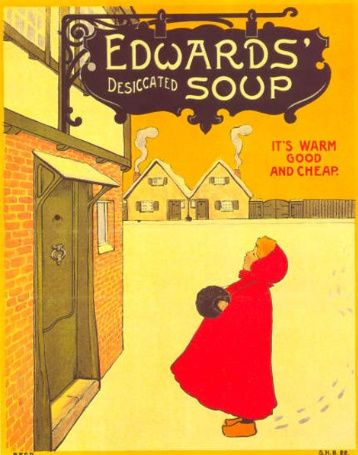
Source: Bert Christensen's Illustration Gallery
Thanks for trudging in the cold and snow to drop by today!
The soup kettle's on at this very moment, and the savory aroma of Mulligatawny has drifted upstairs to my office. Mmmmm, it's a new recipe, and I can hardly wait to taste it.
While it's simmering, thought I'd share a few more soup picture books. It's the best way I know to properly celebrate National Soup Month. Combine these titles with my first thematic list from 2008 for a hearty, satisfying feast.
BEAN SOUP/SOPA DE FRIJOLES by Jorge Argueta, pictures by Rafael Yockteng (Groundwood Books, 2009). This bilingual free verse recipe poem shows us how to make black bean soup via charming, vivid imagery. After all, soup is more than just soup, especially if it's prepared in "a pot round as the moon and as deep as a little lake." A little boy (with his mother hovering in the background), measures out the ingredients, sorts the beans (which "clink a little song"), mixes everything together, and joyfully anticipates sharing the soup with his family. Love how Argueta captures the loving poetics of soup: garlic comes dressed in a little white dress, beans dance together, and the house "smells wonderful like the earth after the first winter rains." So nourishing! Yockteng's muted palette of browns, blues, and greens enrobes the story in warmth and comfort, and asterisks specify which prep steps require adult assistance.
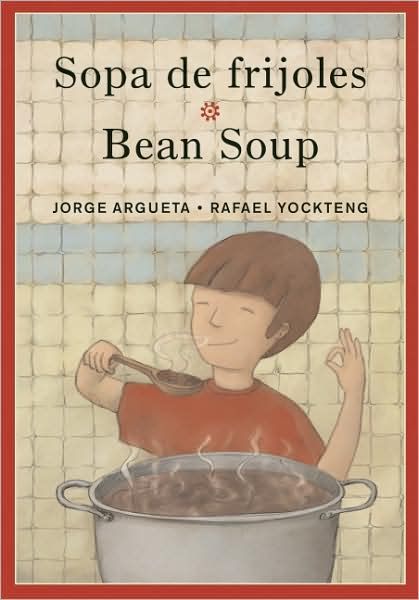
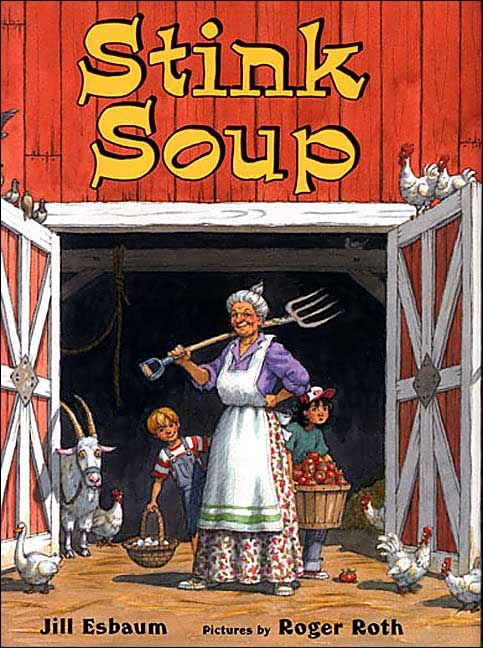
STINK SOUP by Jill Esbaum, pictures by Roger Roth (FSG, 2004). So how do you feel about tomatoes? Annabelle hates them, but must help put up a mountain of them when she and her mischievous brother, Willie, spend the week at Granny's. If only she hadn't promised Mama to keep Willie out of trouble! His antics compound her tomato misery, as he torments the goat, lassoes the chickens, and climbs up the windmill. Somehow he's got Granny believing all the mayhem is Annabelle's fault, and even worse, they have to eat stewed tomatoes for supper! Poor Annabelle can't bring herself to tell Granny how she really feels, but as luck would have it, Willie messes with a skunk and Granny must make "stink soup" to get rid of the smell. Annabelle's thrilled, as she'd rather bathe in tomato juice than drink it -- and Willie finally gets his comeuppance. Roth's folksy, exuberant illos capture all the energy and wry humor of this lively fun-on-the-farm tale.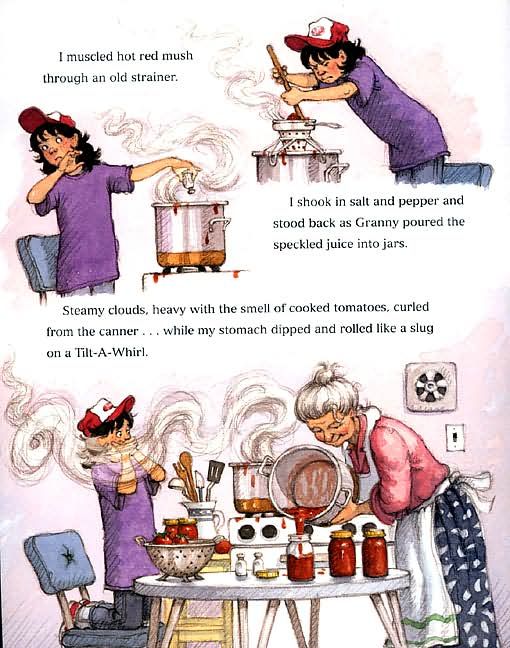
BONE SOUP by Cambria Evans (Houghton Mifflin Harcourt, 2008). A perfect offering for the ghoulish gourmet, this Halloween friendly adaptation of Stone Soup serves up a cauldron full of deliciously disgusting ingredients: stewed eyeballs, bat wings, frog legs, dried mouse droppings, slime, sludge, even toenail clippings. Finnigin the Eater, a skin-and-bones traveler known far and wide for his ravenous appetite, displays hi
Blog: jama rattigan's alphabet soup (Login to Add to MyJacketFlap)
JacketFlap tags: thematic book lists, fall for restaurants 2009, Add a tag
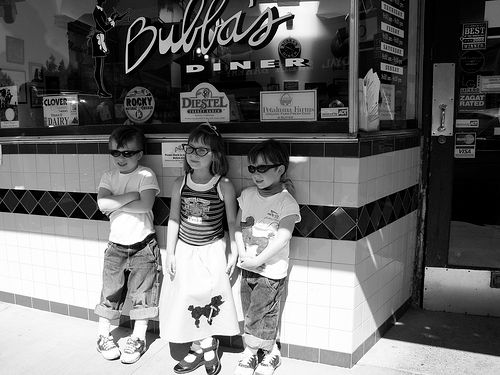
photo by cproppe.
What, you're back again?
I was sure visiting all those restaurants last time would have kept you satisfied for at least two days, what with dinosaurs, a wild menagerie of zoo animals, Chinese take-out, greasy bugs, sprinkly seaweed and a mountain of cherry pies.
*looks at you and recognizes lean, hungry look*
Well, I can't really blame you, because we seem to have the same habit: we like to eat every day. No problemo. I'm happy to take you on another restaurant tour. Hope you're in the mood for more Chinese, some burgers, wild tigers, a troublesome bee, and a stampede of oinkers. Oh, and you have to mind your table manners.
Come and get it while the food is hot!
DIM SUM FOR EVERYONE by Grace Lin (Knopf, 2001). It's impossible to resist the inherent charm of "many little dishes" on carts and tables brimming with such delicious treats as egg tarts, turnip cakes, fried shrimp and steamed dumplings. Enter a busy Chinese restaurant and sit down with this family of five as they choose their favorites and eat their fill. Little ones will get a good sense of the bustling atmosphere and lively talk that defines this beloved tradition. An author's note provides a little history and describes several interesting yum cha (tea drinking) and dim sum customs. The endpapers alone are worth the price of admission ☺!

FRIDAY NIGHT AT HODGES' CAFE by Tim Egan (Houghton Mifflin, 1995). It's Friday night and all the regulars are gathered at Hodges' Cafe, a cozy spot known for its delicious desserts and one crazy duck. Despite the "No Tigers Please" sign on the door, three menacing tigers saunter in, dressed in expensive-looking clothes and talking with fancy words. They set the customers a-tremble, but the duck stands up to them. Until. The biggest tiger wants "Sautéed Duck in an orange glaze." A wild chase ensues, with friends tossing cheesecakes and rhubarb pies. The tiger catches the duck. Who will save him? Expect understated humor, a tense moment or two, and a duck diving into a large raspberry tart. Food to tame the savage beast. Chocolate soufflé, anyone?
HAMBURGER HEAVEN by Wong Herbert Yee (Houghton Mifflin, 1999). Sometimes you just crave a good burger. But not just any burger. Certainly not the same old cheesburgers they've been serving at Hamburger Heaven. No wonder fewer customers have been coming. Pinky Pig can't afford to lose her job (she wants to buy a new clarinet), so she comes up with a new menu to keep the restaurant open. Take a seat and enjoy Pinky's highly original toppings. Bet you've never had a burger topped with fried worms and slugs, or crawling with beetles. Lively rhyming couplets make for a good read-aloud and a customized meal.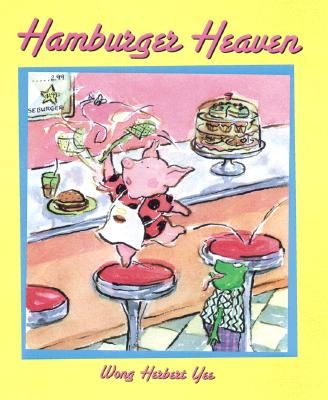
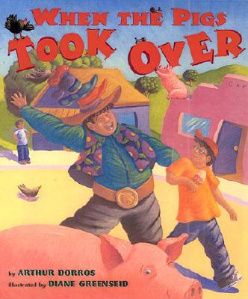
WHEN THE PIGS TOOK OVER b
Blog: jama rattigan's alphabet soup (Login to Add to MyJacketFlap)
JacketFlap tags: fall for restaurants 2009, thematic book lists, Add a tag
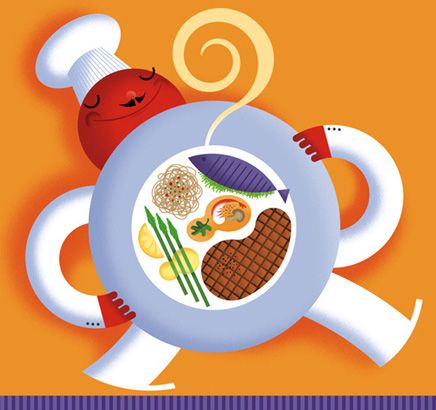
"Ciao Time" by Bob Staake (artcafe2008).
Any time you and your munchkins are in the mood to eat out, no need to call ahead, dress up, or risk the ho-hum food often found on children's menus.
Just skip over to your local library and grab a few of these tasty picture books for meals that will excite, inspire, and feed the imagination. I've been doing my own literary restaurant tour the past few weeks, and am happy to report there are mucho picture books featuring chefs and restaurants. Most of them seem to favor cafés and diners, with lots of animal characters and cumulative tales ramping up the action with every bite.
Strange and wonderful things happen in restaurants, in real life and in books. Though every good picture book features a world unto itself, the world of a restaurant book is a natural gathering place for adventure-hungry, curious, mischievous, sly, zany and sometimes dangerous characters. It's the perfect set-up for an unexpected occurrence, a dramatic entrance, or a lesson on table manners. I got to dine at all these places, eat/read my fill, and it didn't cost me a dime. So take a seat (your table here is always ready), tuck in your napkins, and enjoy!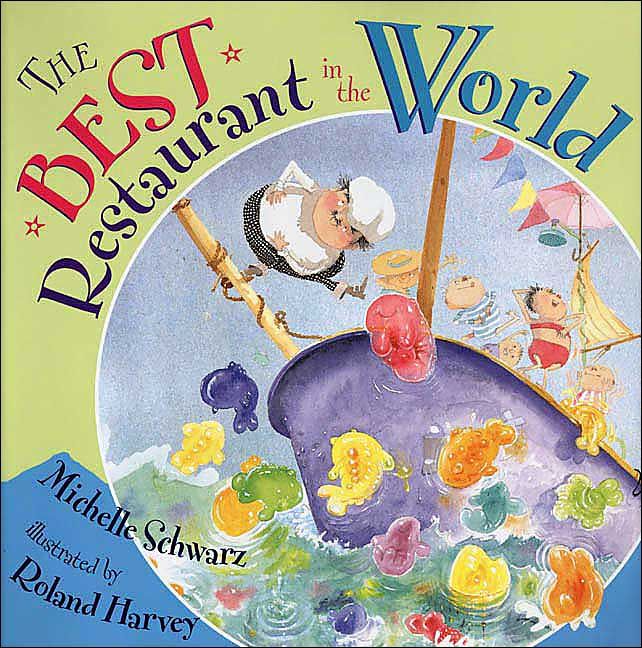
THE BEST RESTAURANT IN THE WORLD by Michelle Schwarz, pictures by Roland Harvey (Dutton, 2002). The perfect antidote for boring restaurants serving boring food and filled with boring conversation is the Super Sailing Sea Restaurant. Be patient, wait on the beach, and if you're lucky, little round Chef Peppi will come ashore in his tin tub to pick you up for a feast beyond your wildest dreams: cotton candy clouds, fish made of Jello tasting like anything you could wish for, floating chocolate castles, and a special dessert that can only be found at the bottom of the ocean (seaweed sprinkled with jimmies -- salty, sweet, colorful and round). Harvey's droll, highly detailed pencil and watercolor illos are ice-creamy delicious. An Australian import that will set imaginations soaring.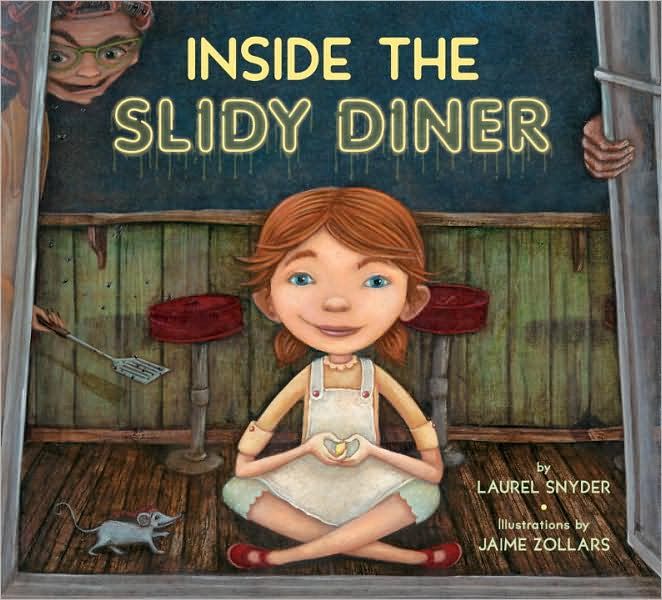
INSIDE THE SLIDY DINER by Laurel Snyder, pictures by Jaime Zollars (Tricycle Press, 2008). Deliciously disgusting in all its greasy, slimy, insect-ridden glory, the Slidy Diner is a must stop if you're in the mood for an unforgettable meal. Join Edie, who transgressed over a stolen lemon drop and is happy to describe the place, the customers, and the food (?) she knows all too well. On the menu: recycled sticky buns covered in bugs, pumpkin asparagus pie with unidentified crunchy-bit topping, Greasily Niblets, hive-inducing coffee, ladyfingers and the house specialty, Lumps and Dumplins. Compelling, highly original and darkly comic, strange is as strange does. Every word works, the illos take us beyond, and we'll never know -- real or imaginary? Brilliant work by two former waitresses; definitely not a chain restaurant ☺! (Faboo review at 7-Imp.)
Add a Comment
Blog: jama rattigan's alphabet soup (Login to Add to MyJacketFlap)
JacketFlap tags: thematic book lists, apple picture books, Add a tag
"It is remarkable how closely the history of the apple tree is connected with that of man." ~ Henry David Thoreau.
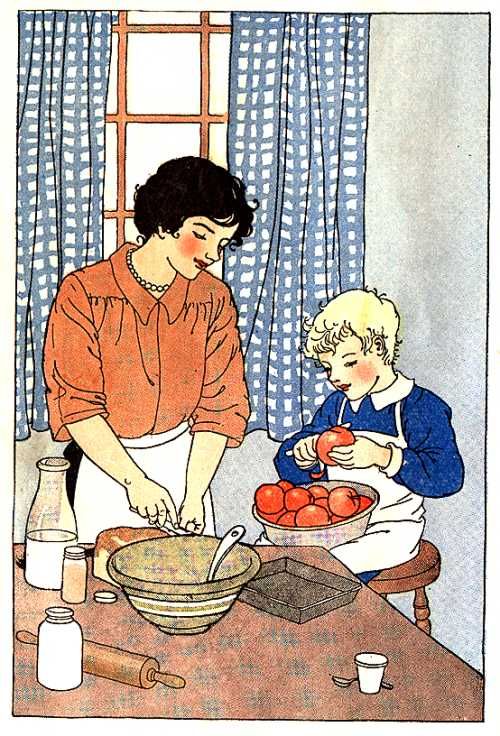
Come November, the best of the apple crop has been harvested. Is your larder stocked with your favorite varieties for the chilly days ahead? Nothing says fall like the aroma of cinnamon wafting through the kitchen, promising a freshly baked apple pie, cobbler, or crisp. 

While I'm waiting for my pie to bake, thought I'd add several more apple picture books to the list I started last year. I was happy to discover some wonderful new titles for 2009, as well as some older books I missed before. One can never have too many apples, right?
Bite into any one of these for a crisp, juicy, flavorful treat. Enjoy!
NONFICTION:
APPLES FOR EVERYONE by Jill Esbaum (National Geographic, 2009). This inviting, photo-luscious charmer begins with basic facts about the life cycle of the apple from blossom to harvest, and then tempts the reader with delectable examples of how apples are consumed -- dipped in caramel, baked in pies, cooked into applesauce, pressed for cider.
Esbaum's simple text is punctuated with wonderful sensory detail. Apples are described with "golden spreckles or snazzy stripes," "round as a ball or tall and bumpy bottomed." She polishes off the feast with Johnny Appleseed, apple anatomy and apple names. The familiar sensation of the all-important CRUNCH, followed by juice dribbling down the chin, will keep this satisfying introduction to America's favorite fruit fresh through repeated readings. (Picture the Seasons series, paperback original.) 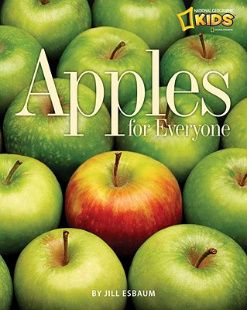
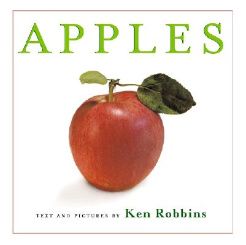
APPLES by Ken Robbins (Atheneum, 2002). Another fetching photo-essay covering cultivation, pollination, harvesting, and consumption. Texture rich close-ups pull the reader right into the pages -- apple picking, drinking a cold glass of cider, biting into big fruit. An Author's Note provides a bit of history, lore, and literary references. Accessible with a highly appealing format.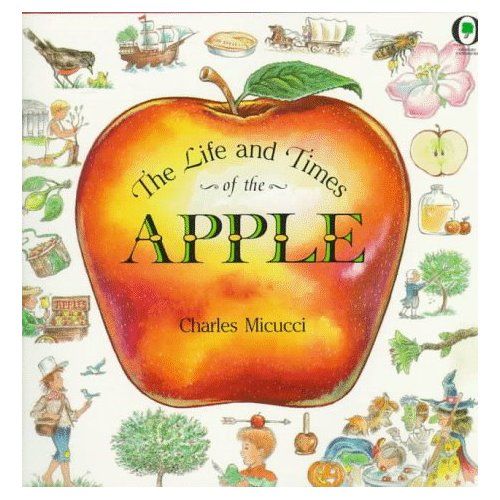
THE LIFE AND TIMES OF THE APPLE by Charles Micucci (Orchard Books, 1992). A bountiful harvest of information sure to please any little apple eater who's curious about life cycle, harvesting, uses, varieties, history, and legend. The book contains over 100 detailed, full-color illos and diagrams presented in a clear, concise, lively format. Especially interesting: Parts of an Apple Flower, Apple Uses (yum!), Apple Timeline and dispersion throughout the U.S. Perfect for upper elementary readers.
FICTION:
APPLESAUCE SEASON by Eden Ross Lipson, illustrated by Mordicai Gerstein (Roaring Brook Press, 2009). If ever there was a lip-smacking, body-and-soul-satisfying book, this is it. Liberally flavored with love, family tradition, and a young boy's sheer joy over every aspect of applesauce making, this story will inevitably inspire readers of all ages to make some of the tasty stuff for themselves.
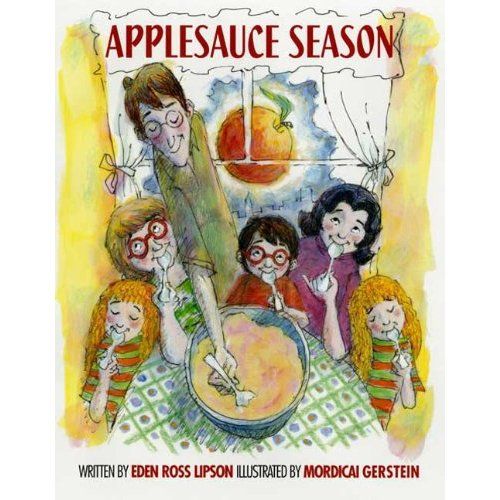
The frantic energy of Gerstein's ink and watercolor illos, rendered in a predominantly red, green, and blue palette, keeps the reader happily engaged and salivating page after page. Whether it's the bushels teeming with apples at the farmers' market, sliced apples resplendent on cutting boards, bobbing about in a big pot, or the table set with roast beef, potato pancakes, apple cake and crepes, the spirit of seasonal celebration comes through loud and clear. Adorable endpapers, featuring apple varieties and character faces, are worth the price of admission alone, and of course, the author's applesauce recipe is included (also available online here). 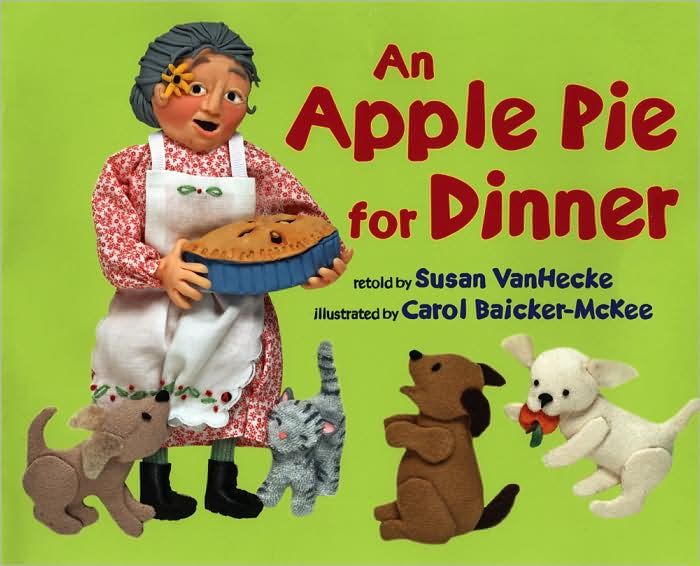
AN APPLE PIE FOR DINNER by Susan VanHecke, illustrated by Carol Baicker-McKee (Marshall Cavendish, 2009). Based on the English folktale, "The Apple Dumpling," this toothsome tale features Granny Smith, who seeks apples to make a pie for dinner. She sets out with a basket of plums and travels the countryside, trading off feathers, flowers, a gold coin, and a puppy until she finally gets her apples. Everyone she's met follows her home, where they help make and devour the pie. Baicker-McKee's remarkable three dimensional, mixed-media bas-relief illos give the book a decidedly homespun flavor (oh, the wonders of baked polymer clay, found objects, wood and pipe cleaners). Recipe for apple pie included.
APPLE COUNTDOWN by Joan Holub, illustrated by Jan Smith (Albert Whitman, 2009). Kids will enjoy counting down from 20 to 1 in this lively story about a school field trip to an apple farm. The rhyming text keeps things moving right along, as the class boards and rides the bus (imagining what they might see), rides a train, counts cows, ducks, trees, even bee hives. Best of all is picking the apples and, of course, apple pies. Smith's 'loose tooth' subtext adds humor, and it's nice to see a racially diverse group of students. 
APPLE FARMER ANNIE by Monica Wellington (Puffin, 2001). There is something decidedly sweet and charming about this simple story featuring Annie, who picks the apples from her orchard, sorts and sizes them, then makes cider, applesauce, muffins, cakes and pies. She takes her apples and baked goods to the farmers' market in the city, where she sells everything and then returns home with a wonderful feeling of satisfaction. The brightly colored illustrations with their clean lines are eminently pleasing to the eye, and the spare text is great for reading aloud. Includes recipes for applesauce, apple muffins, and applesauce cake. Yum!
My recipe for Apple Crumb Pie is here!
Well, it looks like my pie is done. Would you like some? Be sure to let me know if I missed any of your favorite apple books!
Click here to see my first batch of apple picture books, and here for more apple recipes.
There are some apple pie picture books in my Upper Crust Pie List, too.
*licks lips*
Copyright © 2009 Jama Rattigan of jama rattigan's alphabet soup. All rights reserved.
Blog: jama rattigan's alphabet soup (Login to Add to MyJacketFlap)
JacketFlap tags: thematic book lists, taste of summer, gardening, Add a tag

Are you lucky enough to have your own vegetable garden this year?
Right about now, I'm envying those of you who are enjoying homegrown lettuce, beans, peppers and zucchini, with the promise of juicy red tomatoes yet to come. Since we moved to the woods, we don't get enough sun to grow a decent garden, and because of the deer, we don't have any flower beds or anything.
But I can certainly get into the gardening spirit by reading picture books which focus on the miracle of growth and cultivating a love of nature. Whether you fancy flowers, shrubs, or veggies, you're sure to enjoy dipping your trowel into these stories.
Share this bountiful crop with the munchkins in your house, and watch the wonder and ideas blossom!
Jack's Garden by Henry Cole (Greenwillow, 1995). Based on the classic rhyme, "This is the House that Jack Built," this cumulative story shows how Jack planted his garden, step by step -- gathering tools, preparing the soil, dropping seeds, waiting for seedlings to sprout after rain, then finally experiencing the joy and excitement of buds and blossoms. Framed colored pencil illustrations are bordered by names and diagrams of insects, seeds, flowers, birds, and eggs. An Author's Note, "To Start Your Own Garden," offers general tips. Kids will love the dramatic progression from bare earth to a lush, colorful spectacle of flora and fauna.
Mortimer's First Garden by Karma Wilson, pictures by Dan Andreasen (Margaret K. McElderry, 2009). A charming tale of how Mortimer Mouse, craving something green in early spring, sacrifices one of his sunflower seeds by planting instead of eating it. Using an acorn shell to water his little seed, Mortimer waits and waits and waits for his miracle to occur. Can just one tiny seed turn into many? Simple, uncluttered oil paintings focus on Mortimer's ups and downs, with the perspective echoing the possibility of something bigger emerging from a tiny source. The final illo of Mortimer resting amongst his pile of seeds is adorable. A good reminder of the importance of keeping the faith.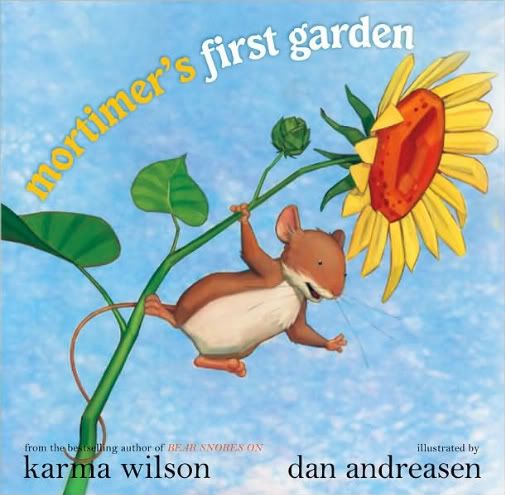
The Curious Garden by Peter Brown (Little, Brown, 2009). Liam discovers an abandoned railway in his neighborhood, and proceeds to nurture the struggling wildflowers and plants sprouting between the tracks. With water, sunshine, and Liam's serenades, the plants soon begin to thrive and spread down the railway, gradually greening up what had once been a drab, dreary city. The following spring, with new plans and new tools, Liam's efforts blossom even more -- other gardeners all over the city soon begin to plant their own rooftop gardens. Inspired by the Highline, an abandoned elevated railway-turned-park in West Manhattan, The Curious Garden shows how eager nature is to explore the places we have forgotten, and how the efforts of one person can make a big difference in changing the world. 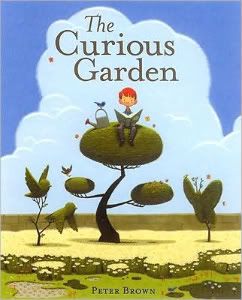
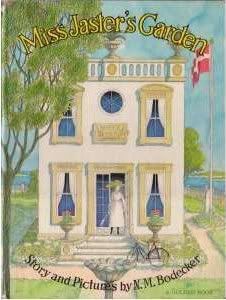
Miss Jaster's Garden by N.M. Bodecker (Golden Books, 1972, reissue 2001). Truly a treasure, this gem from the past was written and illustrated by the Danish artist most commonly associated with Edward Eager's fantasy novels, Half Magic and Knight's Castle. One bright May morning, a near-sighted spinster named Miss Jaster plants her spring flower garden, not realizing she has sprinkled seeds all over Hedgie the hedgehog. All along, the two have lived quietly and happily -- Hedgie in his little corner of the garden, and Miss Jaster in her square, whitewashed house.
Hedgie doesn't mind the seeds, or the gentle scratching of his quills, or even the shower from Miss Jaster's watering can. But soon he feels a little strange and restless, "like a thousand finy fingers tickling his skin." When he sees himself in a puddle, he is amazed to discover little spikes and shoots sprouting among his quills. But is he now a flower bed or vegetable garden? And what happens when Hedgie finally blooms, and Miss Jaster mistakes him for a flower thief? This quaint, gentle story of peaceful co-existence, brought to full flowering with Bodecker's pastel ink and watercolor illos, will surprise, delight, and tickle your sensibilities. A New York Times Best Illustrated Book.
Mrs. Spitzer's Garden by Edith Pattou, pictures by Tricia Tusa (Harcourt, 2001). Mrs. Spitzer extends her mastery of gardening skills to the nurturing of her young pupils in this inspiring story first written as a gift for the author's daughter's kindergarten teacher. Truly wise and discerning, Mrs. Spitzer recognizes individual differences with patience and foresight, anticipating needs and encouraging her charges whenever necessary. A paean to good teachers everywhere, this is the perfect end-of-the-school-year teacher gift.
How Groundhog's Garden Grew by Lynne Cherry (Blue Sky Press, 2003). One day, while Little Groundhog is nibbling on some lettuce from his neighbor's garden, Squirrel scolds him and suggests he plant his own vegetable garden. Groundhog admits he doesn't know how, so Squirrel volunteers to teach him. Beginning with seed gathering in the fall, the story follows the entire cycle of the gardening year. Once spring arrives, Squirrel shows Groundhog how to plant rows of root crops like potatoes, radishes, carrots, and parsnips; vine and leafy veggies like beans, peas, tomatoes, peppers, spinach and kale; and ground creepers like pumpkin and squash.
Cherry's highly detailed botanical illustrations, some full bleed, some framed by depictions of insects, or the progression from seed to vegetable, are simply gorgeous and a true feast for the eyes. Double page spreads of the fall harvest and Thanksgiving celebration with all the animal friends remind us of the deep, satisfying pleasure of growing one's own food. An Author's Note detailing Cherry's personal experiences will surely inspire budding naturalists.
The Gardener by Sarah Stewart, pictures by David Small (Farrar, Straus & Giroux, 1997). A classic that grows more beautiful and satisfying with each reading, this Depression era story about Lydia Grace Finch is easily the most emotionally resonant of the bunch. After her father loses his job, Lydia is sent to the big city to live with her Uncle Jim, a baker who's not in the habit of smiling very much. Small but strong, Lydia packs her suitcase with seeds and a passion for gardening that ultimately beautifies the bakery, pleases the customers, and melts Uncle Jim's heart. Her secret rooftop surprise and Uncle Jim's response are truly uplifting. David Small's warm ink and watercolor illos trace Lydia's earnest efforts, as she transforms a drab city into a place of beauty, with her loving spirit and ability to bloom where she's been planted. The final spread at the train station, showing Lydia and Uncle Jim saying goodbye, says it all. This Caldecott Honor book is told entirely through Lydia's letters home.
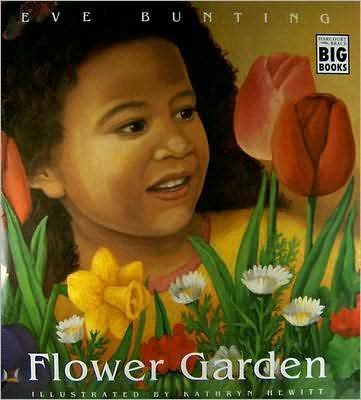
Flower Garden by Eve Bunting, pictures by Kathryn Hewitt (Harcourt, 1994). This sweet story, told in simple rhyming text, captures the anticipation of a little girl planting a flower box as a surprise for her mother's birthday. With her dad, she purchases bedding plants, carts them home on a bus, carries them upstairs to their apartment, fills the planter with potting soil, then puts in pansies, daisies, daffodils, geraniums, and tulips. The beautiful oil paintings are a gift in themselves, perfectly evoking the singular pleasure of being gifted with flowers.
♥ For even more, check out this thematic list of books about Seeds and Growing Things at The Miss Rumphius Effect.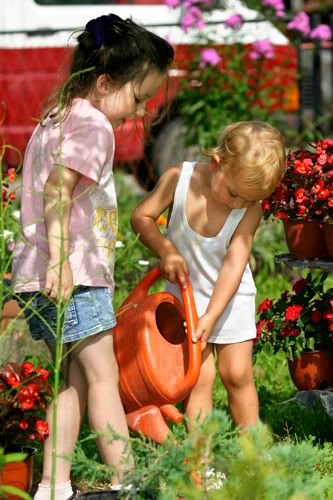
Happy Gardening!
*child gardeners from DifferentWay's photostream.
Blog: jama rattigan's alphabet soup (Login to Add to MyJacketFlap)
JacketFlap tags: asian pacific american heritage month, thematic book lists, may days, Add a tag
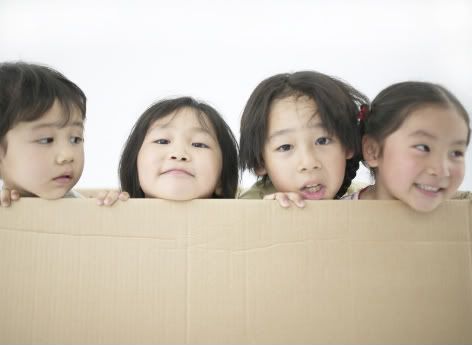
It's been quite a month -- flowers, salad, strawberries, and Asian Pacific American Heritage. As far as I'm concerned, every month is a time for ethnic pride, learning more about other cultures, and getting excited over books that feature new voices and perspectives. Do you need an excuse to eat more dim sum? Not me!
One of the ways I've been celebrating APAHM is to pick up some of the picture books I'd heard about, but never got around to reading. It was good to see titles featuring more Korean, Japanese, and South Asian characters, alongside the plentiful store of Chinese books. We still need more stories about Hawai'i and the Philippines, though, so I'd better get busy.

Anyway, today I'm serving up this tasty stir fry combining the flavors of Korea and China. Each title brims with its own brand of color, texture, and emotional resonance:

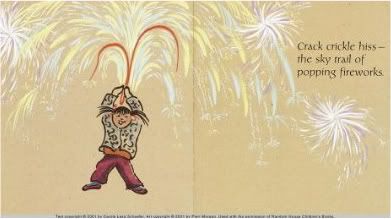
NEW CLOTHES FOR NEW YEAR'S DAY by Hyun-Joo Bae (Kane/Miller, 2007). Translated from the original Korean, this sweet first person narrative follows a little girl who's celebrating the Lunar New Year by putting on new clothes her mother has made for her. There is joy in each piece, from the crimson silk skirt, to the rainbow-striped jacket, delicate socks embroidered with flowers, to the hair ribbon of red and gold.
Hyun-Joo Bae's winsome illos showing the girl's expressions as she wraps the skirt around herself, tumbles over while putting on her socks, and struggles with her hair ribbon, are wonderfully captivating and provide an emotional focal point for the largely formal, precisely composed settings. An Author's Note describes the significance of new clothes for New Year's Day, and there's a lovely diagram of the costume with proper Korean names for all the pieces.
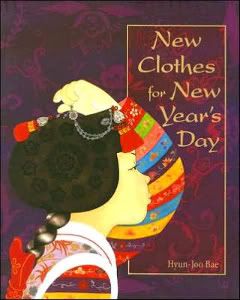
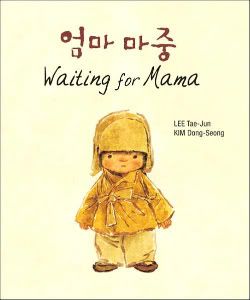
WAITING FOR MAMA by Lee Tae-Jun, pictures by Kim Dong-Seong (North South Books, 2004). This haunting, poignant little tale, set in 1930's Korea, features a small boy waiting at a streetcar station for his mother to arrive. It's winter, and the boy seemingly waits a long time, in the cold and snow, as conductors on arriving streetcars answer his question about the whereabouts of his mother with a matter-of-fact, "Do I know your Mama?" The pastel and pencil illustrations, rendered in subdued ivories, browns and olives, enlarge the story, which is told in Korean Hangeul alongside its English translation. The boy is a paragon of patience, so tiny on the platform amongst other travelers, so alone in a big world. The final double page, wordless spread shows the boy and his mother walking home hand in hand in the midst of a blizzard. The story seems simple, but it's capable of stirring deeper emotions, primarily because of the illustrations (the story was originally published in a newspaper in 1938).
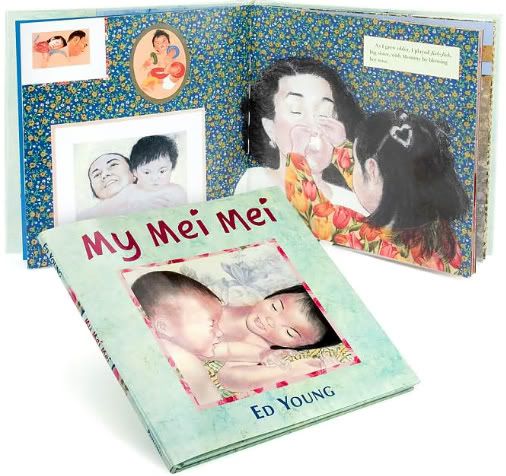
MY MEI MEI by Ed Young (Philomel, 2006). This is the true story of how Ed Young and his family went to China to adopt a little sister, or "mei mei" for his daughter Antonia, and how she learned to be a big sister to little Ananda. Told from Antonia's point of view, it traces the significant moments of this sibling relationship -- starting from when Antonia first asks for a little sister, to them flying the "friendly sky" to China, to seeing Ananda for the first time, to experiencing jealousy and realizing "she was not all she ought to be" (requiring special teachers to learn to walk and talk). There is love and warmth in the simple yet significant ways the sisters eventually bond, and the gorgeous gouache, pastel and collage illustrations render the experience with such luminosity it takes the breath away. That I can feel a father's love in every aspect of the story's execution only deepens my veneration for it.

RUBY'S WISH by Shirin Yim Bridges, pictures by Sophie Blackall (Chronicle Books, 2002). A simply told, inspiring story based on the author's grandmother's experience of growing up in turn-of-the-century China at a time when females were married off rather than educated. Ruby (named for her love of the color red), displays an independent spirit and love for learning, even while respecting what tradition dictates. Young readers will likely admire Ruby's quiet determination as she continues with her studies while fulfilling domestic obligations. Thanks to a special relationship with her wise and enlightened grandfather, Ruby eventually realizes her wish of attending university. Sophie Blackall's gouache illos effectively depict Sophie's unconventional personality and contain just the right kind of details to keep readers engaged all the way through.
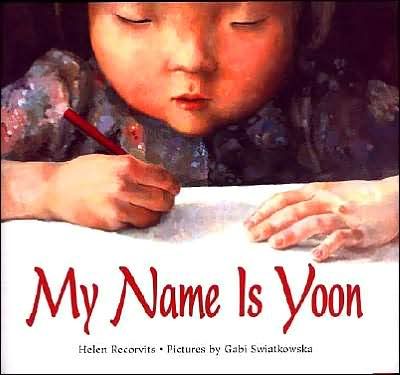
MY NAME IS YOON by Helen Recorvits, pictures by Gabi Swiatkowska (FSG, 2003). The satisfying story of how a Korean girl, Yoon, learns to adjust to her new life in America. Feeling alone and alienated from her classmates, Yoon resists writing her name, which means "Shining Wisdom," in English. She much prefers to write her name in Korean, where the "symbols dance together," saying that in English, all the lines and circles stand alone. Each day as the teacher encourages her to write "Yoon" in English, Yoon chooses instead to write a word that reflects her inner feelings -- a CAT, which could hide in a corner, or a BIRD, which could fly back to Korea.
One day, a classmate gives Yoon a cupcake, and she expresses her happiness by writing CUPCAKE. Growing feelings of acceptance coupled with the teacher's smiles, finally prompt Yoon to write her name in English, as she realizes she will still be Yoon in any language. Swiatkowska's paintings dramatically depict Yoon's transition from alienation to acceptance, as they go from starkly spare and surreal to warm and humanizing.
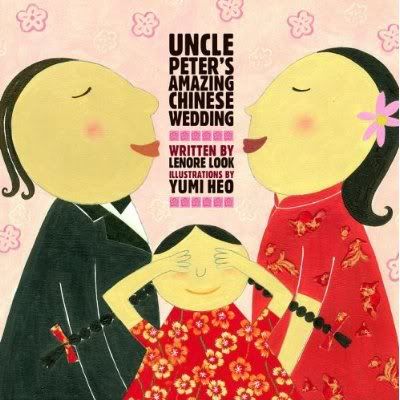
UNCLE PETER'S AMAZING CHINESE WEDDING by Lenore Look, pictures by Yumi Heo (Atheneum, 2006). Feisty, spirited Jenny feels like "an umbrella turned inside out" at the prospect of her Uncle Peter's upcoming nuptials. After all, she's always been his best girl, and now, Stella, an interloper in a red dress who's the new center of Peter's universe, threatens her every happiness. Several fascinating Chinese wedding traditions, including bargaining for the bride, bed jumping, and exchanging good luck money, are described in Jenny's forthright, humorous voice. The lively telling is tempered by Jenny's very believable sadness at losing her uncle, and Yumi Heo's quirky, Maira Kalmanesque pencil, oil and collage illos perfectly depict this noisy, hectic family celebration with its jumble of emotions. Jenny will win you over from the start.

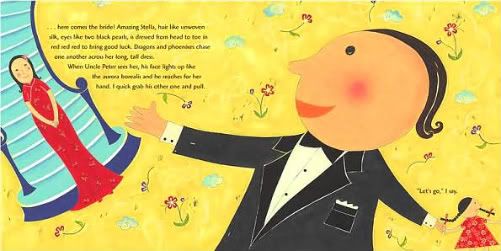
Happy Reading! Add a Comment
Blog: jama rattigan's alphabet soup (Login to Add to MyJacketFlap)
JacketFlap tags: thematic book lists, comfort food month, Add a tag
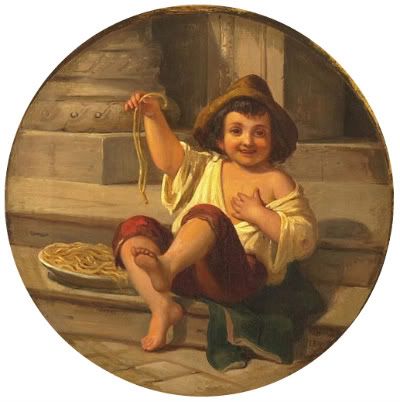
Slip, sloop, slurp. Twirl, wrap, spin. Open up wide, shove the pasta in!
Oh, hello. I didn't see you there at first.
Only one more day to celebrate National Noodle Month. Have you had your share of spaghetti, ramen, lo mein, kugel, udon, chap chae, and kuksoo? And while we're at it, what about yakisoba, pancit and pad thai?
Sigh. So many noodles. So little time.
What to do? Boil some linguini, read some pasta picture books, and declare every month, noodle month!
Here, twirl these around on your fork: *smacks lips*
Everybody Brings Noodles by Norah Dooley, pictures by Peter J. Thornton (Carolrhoda Books, Inc., 2002). It's the Fourth of July, and everyone in Carrie's neighborhood is getting ready for a block party. It was her idea, and while she's excited that so many people are bringing noodle dishes (her favorite), she's disappointed that all the preparations have kept her so busy, she won't be able to participate in the talent show. The story mainly serves as a vehicle for introducing the multiethnic characters in the neighborhood, who bring tantalizing batches of pasta pesto, orzo, zaru soba, sesame noodles, and kugel. Thornton's pastel illos capture the busyness and anticipation of a friendly holiday celebration, while seven yummy noodle recipes will definitely extend the enjoyment of this book. (ages 5+)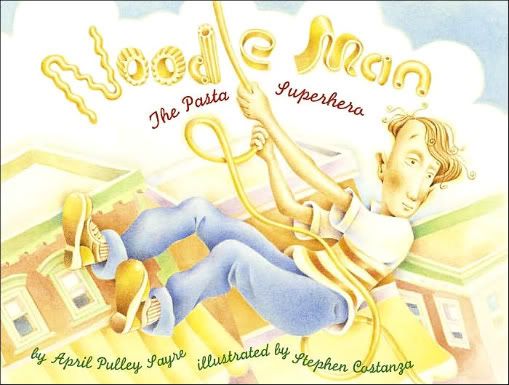
Noodle Man: The Pasta Superhero by April Pulley Sayre, pictures by Stephen Castanza (Orchard Books, 2002). If you like your pasta exuberant, zany, and pun-wonderful, this is the book for you. Al Dente's family is in the pasta making business. But it seems the neighbors in Durum have stopped eating fresh pasta in favor of pizza delivery. Al does not want their business to fail, so he invents a portable fresh pasta making machine. Though he doesn't do very well peddling pasta door to door, his wondrous noodles come in handy when it comes to catching thieves, rescuing people from a burning building, and helping people sproing across a flooded street. Kids will giggle over Noodle Man's exploits and love Castanza's frantic, eye popping watercolor illustrations. Wouldn't you love a grandma who knits sweaters from spaghetti? (ages 4-8)
On Top of Spaghetti, written and illustrated by Paul Brett Johnson, with lyrics by Tom Glazer (Scholastic Press, 2006). A hilarious adaptation of the original song/parody, that has Yodeler Jones, a hound who owns the Spaghetti Emporium and Musicale, eager to upgrade his menu by creating "the most dee-licious meatball this side of Sicily." It's all because a fried fritter fricassee parlor has opened next door, stealing all his business, which consists of a motley but endearing crew of animal friends. Of course there are a couple of big sneezes that send Jones' meatball a-flying, with side-splitting results. Johnson's illos captivate and engage with grand explosions of action and color. Includes full lyrics and a recipe for Yodeler's Spaghetti and Meatballs. (ages 4-8)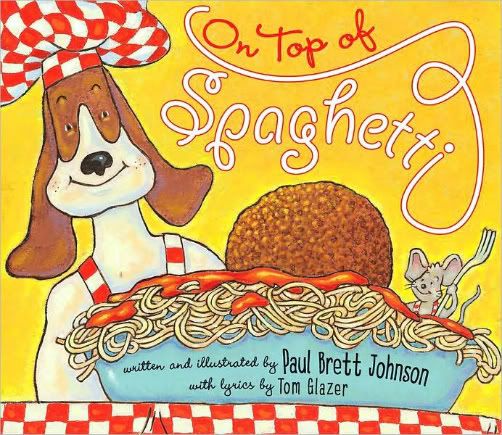
The Story of Noodles by Ying Chang Compestine, pictures by YongSheng Xuan (Holiday House, 2002). A lively, fetching tale of the three Kang brothers, who inadvertently "invent" mian tiao (flour strips), while they're supposed to be making dumplings for an annual cooking contest. Kids will love how a trio of mischievous boys manages to turn a misadventure into a winning dish. Xuan's papercut illos with bold outlines resemble stained glass, and presents interesting details about ancient Chinese village life. An Author's Note discusses the origin of noodles, and a tempting recipe for Long-Life Noodles will make kids want to "eat a drumstick," "suck a worm," and "cut the grass," just like the Kang brothers. (ages 4-8)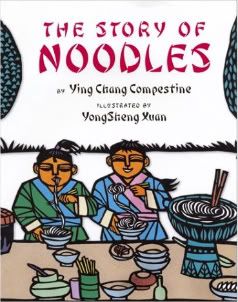

Siggy's Spaghetti Works by Peggy Thomson (Tambourine Books, 1993). Tag along as Siggy takes seven eager kids on a tour of his spaghetti factory, to see how dried pasta is made and packaged. The engaging narrative describes all the machinery used in the process, from the gigantic flour silos to the pasta cutters and dryers. The kids in the book react via speech balloons, and there are numerous sidebars full of interesting facts and tidbits.
Also included: types of pasta and some of the dies used to cut the different shapes, some pasta history, a Chinese noodle-making demonstration via step-by-step diagrams, a talking dog and pig, and a non-gratuitous mention of alphabet pasta. Kamen's ink and watercolor illos and diagrams are wonderfully detailed, with each page turn offering a delightful blend of fun and fact. Love the final double page spread where everyone eats their homework, and Siggy's pasta-themed wallpaper! (age 5+)
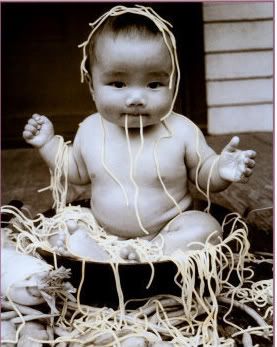
Molto delicioso!
Blog: jama rattigan's alphabet soup (Login to Add to MyJacketFlap)
JacketFlap tags: thematic book lists, holiday treats, literary cookbooks, Add a tag
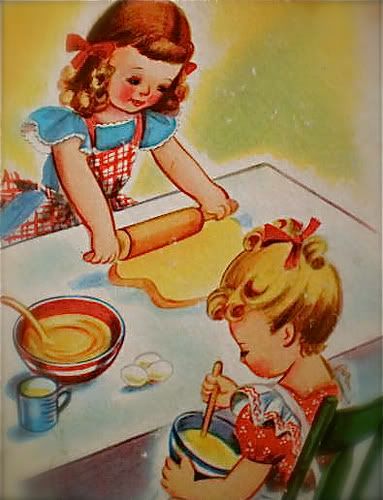
So, I see you're here for the Second Batch.
Now we know you love to eat books. Don't deny it. I saw you drooling and licking some of the cookbooks from the First Batch. Oh, you don't actually eat the books, you just like to make and eat the food from the books?
Alrighty then, dig in:
THE LOUISA MAY ALCOTT COOKBOOK, compiled by Gretchen Anderson, pictures by Karen Milone (Little, Brown, 1985). How I love this little book; it contains 28 recipes grouped with scenes from Little Women and Little Men. What is especially notable is that the recipes were initially researched, tested, and compiled by Ms. Anderson when she was just nine years old! She did this for a school project, combining her love for Alcott's books with her favorite hobby, cooking. So, we start out with the famous Christmas morning scene, where the March girls decide to take their breakfast to a poor family. To authentically recreate this, you might try Buckwheat Cakes, Muffins, or Farina Gruel. Or, remember when Marmee was sick in bed with a cold and the girls fixed her breakfast? They made an Omelet with Baking Powder Biscuits.
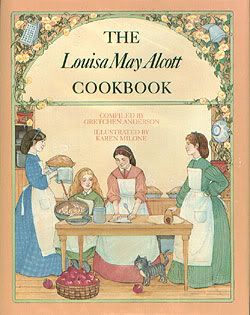
Now, if you're like Jo, with the best of intentions, but a disaster in the kitchen, you'll need more practice (with the Fire Department on alert). But if she could make Molasses Candy, so can you. The recipes from Little Men are solid, traditional American fare, such as Gingerbread, Steak and Potatoes, and Apple Pie. Can't go wrong with those, and all the recipes are rated for level of difficulty. A word about Karen Milone's pen-and-ink drawings: brilliant! Aside from book scenes, she's diagrammed some of the cooking techniques -- little eggs cracked in bowls! Little rolling pins! Squee!
PETER RABBIT'S NATURAL FOODS COOKBOOK, by Arnold Dobrin (Frederick Warne, 1977). Of all the literary cookbooks I own, I've used this one the most. It contains 33 simple recipes, with an emphasis on using fresh, unprocessed, whole foods for: Breakfast and Breads, Sandwiches, Vegetables, Salads, Soups and Desserts. Lots of light dishes made of fruit and veggies -- not for carnivores (what do you expect, Peter was a vegetarian)! I like the use of honey rather than refined sugar, and yogurt as a substitute for mayonnaise. My favorite is Fierce Bad Rabbit's Carrot-Raisin Salad, but there's also goodies like Squirrel Nutkin's Banana-Nut Loaf, Old Mrs. Rabbit's Hearty Vegetable Soup, and Flopsy, Mopsy and Cottontail's Fresh Blueberry Cobbler. No quotes or excerpts are included, but the 7" x 7-1/2" treasure is adorned with Potter's lovely illustrations throughout.
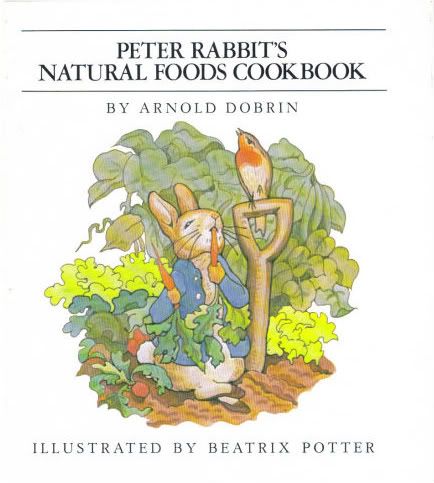
(See also):
PETER RABBIT'S COOKERY BOOK, compiled by Anne Emerson (Frederick Warne, 1980). Twenty-one more recipes, mostly for teas and light lunches, such as Hunca Munca's Rice Pudding and Pigling Bland's Porridge.
THE PETER RABBIT AND FRIENDS COOK BOOK by Naia Bray-Moffatt (Frederick Warne, 1994). Fifteen recipes, including gems like Samuel Whiskers' Roly-Poly Sausages and Peter Rabbit's Party Carrot Cake.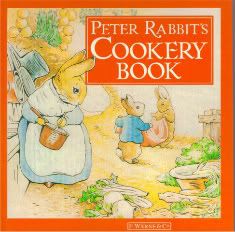

THE POOH COOK BOOK by Katie Stewart, pictures by Ernest Shepard (Methuen, 1971). A honey of a collection containing 58 recipes for all the bear essentials: Smackerels, Elevenses, Teas, Picnics and Expositions, Lunches and Suppers, Desserts, Parties, and Christmas, plus Hot and Cold Drinks. Honey is the favored ingredient, of course, and for bears of very little brain, the easiest recipes are marked with an asterisk. Start with Cinnamon Toast and work your way up to Honey Spice Cake and Spaghetti Supper. If you get stuck, peruse the Pooh quotes and nibble on the pen-and-ink doodles.

THE REDWALL COOKBOOK by Brian Jacques, pictures by Christopher Denise (Philomel, 2005). What an absolute treasure this book is! You don't need to be a Redwall fan to love this collection of three dozen recipes, grouped by the four seasons. The recipes of each section are tied together with a charming new tale featuring familiar Redwall characters, such as Friar Hugo, Pansy, and other adorable Dibbuns, scurrying about the kitchen preparing micey faves like Honeybaked Apples, Hare's Pawspring Vegetable Soup, and Afternoon Tea Scones with Strawberry Jam and Cream. Since Mr. Jacques originally wrote the series for children of a blind school, he is in the habit of describing everything in lavish sensory detail, especially all the food! The full color acrylic and charcoal illustrations are gorgeous -- rich, endearing, engaging, and of course, totally delish. Be sure to "serve warm with a generous helping of storytelling magic."
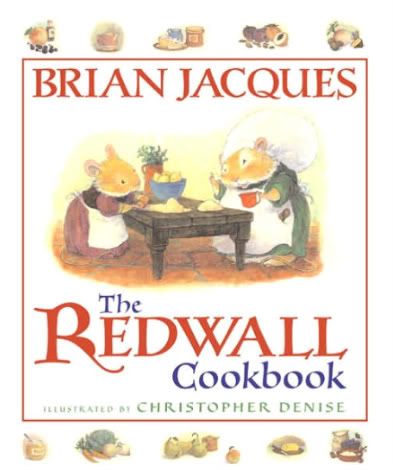
ROALD DAHL'S REVOLTING RECIPES, compiled by Josie Fison and Felicity Dahl, illustrated by Quentin Blake, with photographs by Jan Baldwin (Viking, 1994). "Nose bags on!" "Grub's up!" Prepare to be totally disgusted! Dang, but this cookbook is a lot of fun -- the only one so far with actual photographs of the finished recipes, embellished with classic Quentin Blake quirky drawings.
Or would it have been better not to feast our eyes on such gag-worthy specialties as Snozzcumbers, Mosquitoes' Toes and Wampfish Roes Most Delicately Fried, or Wormy Spaghetti? You get the picture. Everything here is totally Dahlian. Where else could you find a recipe for Lickable Wallpaper or Candy-Coated Pencils for Sucking in Class? No, I haven't actually tried any of these; just reading the ingredients and seeing the pictures is a feast in itself. But reviewers have unanimously rated the recipes as surprisingly delectable, tasting much better than they sound. I will have to try Hair Toffee to Make Hair Grow on Bald Men for Len!
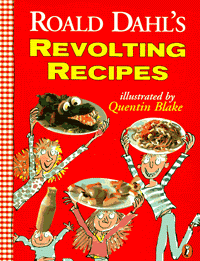
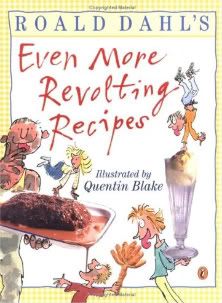
(See also):
ROALD DAHL'S EVEN MORE REVOLTING RECIPES, compiled by Lori-Ann Newman, pictures by Quentin Blake, photos by Jan Baldwin (Viking, 2001). Who could resist another big helping of the same? I am especially interested in A Plate of Soil with Engine Oil and Hot Noodles Made from Poodles on a Slice of Garden Hose.

ONCE UPON A RECIPE by Karen Greene (New Hope Press, 1987). This classic perfectly blends great content (healthy recipes), visual appeal (hand tinted antique woodblock prints), and loads of extras that both inform and inspire (book quotes, tips for preparation and serving, and sample menus). The author's intent was for each page to stir a different dream, and the result is enchanting. Prepare to enter the magical place where food and imagination meet.
Turn to "Morning Glory," where you can experience Shakespeare's Breakfast Sandwiches or Mrs. Tiggywinkle's Pineapple Right-Side-Up Muffins. When you're ready, go to "Bunches of Lunches," for Rumpelstiltskin's Pillows and Runaway Bunny's Custard. The Supper Club menu features Curiouser & Curiouser Casserole and Thumbelina Burgers. Don't worry. Before the day is done, indulge in a "Sweet Dream" -- perhaps Baloo's Mint Brownies or Selfish Giant Cookies. Also included are "Snacks and Sips," Very Nutritious Verses, and The Natural Pantry -- a wonderful primer about the key ingredients in the recipes, such as Maple Granules, Soy Milk, and Whole Grain Baking Mixes. With its nod to whole foods, this cookbook, when first published in 1987, was definitely ahead of its time.
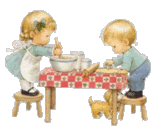
And with that, I'm off to do some holiday baking. Hope you'll check out these cookbooks, eat two Christmas cookies, and call me in the morning.
P.S. Do you know of any other good literary cookbooks? I'm always looking to add to my collection!!
Blog: jama rattigan's alphabet soup (Login to Add to MyJacketFlap)
JacketFlap tags: thematic book lists, holiday treats, literary cookbooks, Add a tag

So, are you ready to get delicious?
Okay, I know you're already scrumptiously talented and have excellent taste when it comes to all things bookish, but I thought I'd tempt you today with some seriously divine, ambrosial offerings -- literary cookbooks.
At this very moment, I'm strapped down to my desk chair, because just thinking about excerpts from beloved, classic books alongside recipes derived from or inspired by the stories, propels me into a state of acute culinary bliss. *Butt rises in chair* See, this topic is actually dangerous -- but for you, I'll take my chances.
I've been collecting literary cookbooks for quite some time. While not all the dishes I've tried have knocked my socks off, I've always been happy just reading the recipes, and appreciating the connections they have with the works. For me, this is a satisfying way of enhancing the enjoyment of a story, since it deepens my understanding of character, historical context, and setting. And if the recipes just happen to be good, it's all gravy.
Though all of these cookbooks are based on children's books, they are actually suitable for cooks and would-be cooks of all ages. They're great for adults who like to revisit old favorites, and will provide hours of fun for grown-ups and kids to work together in the kitchen. And, unlike recipes from ordinary cookbooks, these are seasoned with just the right dash of literary flair.
FIrst batch:
FAIRY TALE FEASTS by Jane Yolen and Heidi E.Y. Stemple, pictures by Philippe Beha (Crocodile Books, 2006). A gorgeous collection featuring 19 retold fairy and folktales, and one original tale written by master storyteller, Jane Yolen, all paired with easy, kid friendly recipes compiled by Jane's daughter, Heidi.
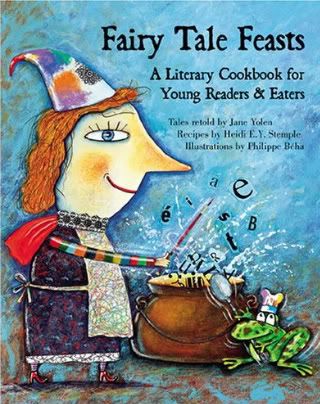
Breakfasts, Lunches, Soups, Dinners, and Desserts are all represented through classic stories like Little Red Riding Hood (Grandma's Potato Salad), Diamonds and Toads (Very French Toast), The Great Turnip (Mashed Turnips), and Brer Rabbit (Carrot Soup). Marginalia featuring folklore origins and food facts are equally delicious, and much of Stemple's good, standard fare will easily become family favorites. All is served up on thick, glossy pages adorned with Beha's bold color illos.
THE WIND IN THE WILLOWS COUNTRY COOKBOOK by Arabella Boxer (Methuen, 1983). If you're in a decidedly British mood, why not pack a hamper and join Toad, Mole, Ratty and Badger riverside? Here, you'll find Food for: Staying at Home, Staying in Bed, The Store Cupboard, Excursions, and Celebrations. The 100+ recipes range from simple to more complicated, and provide an opportunity to sample British standards like Bubble and Squeak, Jam Rolypoly, and Cornish Pasties. In honor of the characters, there are things like Toad Hall Trifle, Ratty's Potted Meat, and Moly's Marmite Soldiers. All garnished with memorable excerpts and line drawings by Ernest Shepard.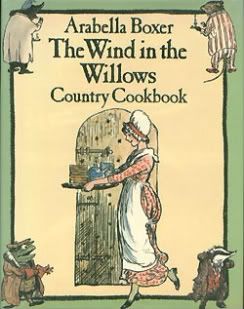
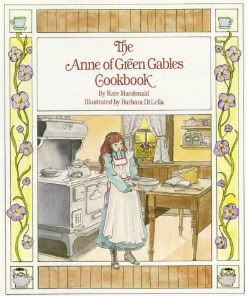
THE ANNE OF GREEN GABLES COOKBOOK by Kate Macdonald, pictures by Barbara DiLella (Oxford University Press, 1985). A slim volume featuring 25 recipes inspired by the Anne books and compiled by L.M. Montgomery's granddaughter. Ms. Macdonald reminds us that "Anne eventually became a good cook by following Marilla's advice." Probably the most memorable food scene of all is when Anne discovers a mouse drowned in the pudding sauce, and this is acknowledged with a recipe for Marilla's Plum Pudding and Warm Caramel Pudding Sauce (I would have tested it for you, but I'm afraid of mice)! Also of note: Diana Barry's Favourite Raspberry Cordial, Poetical Egg Salad Sandwiches, and Anne's Liniment Cake. A table of cooking tips and terms rounds out this lovely collection. Perfect for kindred spirits!
THE LITTLE HOUSE COOKBOOK by Barbara M. Walker, pictures by Garth Williams (Harper and Row, 1979). No doubt you've seen or possibly already own this classic of the genre. Food plays a big role in the Little House books; much of the action is centered on hunting for it, or growing, harvesting, preserving, serving and eating it. When Laura learned how to cook from Ma, she also learned social skills, about human communion. 

So much more than just a cookbook, this volume contains fascinating information about how food was obtained on the frontier, and how it was valued in American pioneer life during the late 19th century. All are authentic recipes from the period adapted for a modern kitchen, and as Ms. Walker states in her introduction, some are more historic than taste sensations. Who can resist Pancake Men, Doughnuts, or Apple Turnovers? Or maybe you'd like to learn how to can, butcher a pig, or churn butter. This is the book that will instill an appreciation for the food on the table, as it traces its connection to the field, the orchard, and the barnyard.
(See also):
*THE LAURA INGALLS WILDER COUNTRY COOKBOOK , by William Anderson (Trophy, 1997), featuring 73 recipes Laura herself compiled at Rocky Ridge Farm in the 30's and 40's.
*My post about Almanzo Wilder's eating habits in Farmer Boy.
THE NARNIA COOKBOOK, commentary by Douglas Gresham, pictures by Pauline Baynes (HarperCollins, 1998). A thoroughly delightful collection of recipes for Breakfast, Lunch, Afternoon Tea, Dinner, Dessert and Drinks, all inspired by foods appearing in C.S. Lewis' Chronicles. Jack, as he was called, was quite a foodie himself, and included in the stories those dishes he himself loved. Did your mouth water when Edmund was tempted with Turkish Delight? I know I was jealous when Lucy had tea with Mr. Tumnus (as fauns are known to be very good cooks).

Douglas Gresham, whose mother, Joy, married Jack later in life, serves up interesting comments about each recipe, either about its culinary origins or place in the stories. Of course there are direct quotes from the books to transport us right back into the wardrobe. Recipes range from simple things like Buttered Eggs to the more challenging Roast Pheasant. Things I would not try: Stewed Eels, Pigeon Pie, Chicken Livers Calormene. Things I'm anxious to try: Lucy's Roast Apples, Sugar Topped Cake, Meat Pasties. Pen-and-ink and watercolor illos by Narnia's original illustrator, Pauline Baynes, are a real treat.

THE BOXCAR CHILDREN COOKBOOK by Diane Blain (Scholastic, 1992). Though not glossy or elaborately illustrated, this collection of standard recipes is one that will be returned to again and again. That's because most of the dishes included are what kids actually like already or would be willing to try. Examples: Pomfret Landing Milkshake, Explorer's Bacon, Boxcar Brown Bread, Benny's #1 Favorite Sandwich, Mike's Favorite Chicken Legs. Each recipe begins with the excerpt from the story that inspired it, followed by very clear step-by-step instructions. There's even a section on Campfire Cooking, with the gold standard of all camp favorites, S'Mores.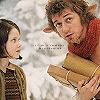 Hope these inspire you to create magic in the kitchen with your family. Look for them at your local library, add them to your personal wishlist, or purchase one as a holiday gift for someone special (you may have to search used bookstores for older titles).
Hope these inspire you to create magic in the kitchen with your family. Look for them at your local library, add them to your personal wishlist, or purchase one as a holiday gift for someone special (you may have to search used bookstores for older titles).
Stayed tuned for the Second Batch of literary cookbooks, coming soon!
Blog: jama rattigan's alphabet soup (Login to Add to MyJacketFlap)
JacketFlap tags: thematic book lists, fall frolic, apple picture books, Add a tag
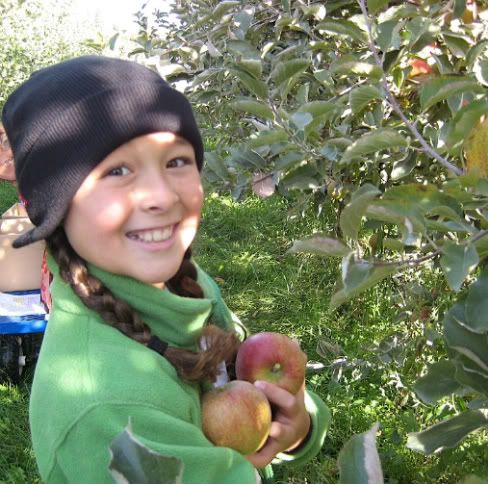
My great-niece, Melia, apple picking in Oregon.
Thanks to you, I just polished off a piece of apple pie.
I wanted to write about apples today, and I needed a boost to get into the right mindset. Just trying to keep it real :)!
I love apples so much that my very first theme on this blog was Apple Month (October 2007). I shared poems, recipes, and various facts, trivia and folklore. Apples, which date back to prehistoric times, are the perfect fruit -- extremely versatile, and the most varied on earth (7500 varieties in the U.S. alone). They were first cultivated in Egypt, and became a favorite of the ancient Greeks and Romans.
Thank you, early American settlers, for bringing apple seeds with you from Europe! Records from the Massachusetts Bay Colony indicate apples were grown in New England as early as 1630. Missionaries, traders, and Native Americans then carried seeds westward, and of course, John Chapman was responsible for extensive plantings of trees in the Midwest.
These Granny Smiths sacrificed themselves for my pie.
Though apples aren't overflowing with vitamins and minerals like some other fruits, they do shine when it comes to Vitamin C, potassium, antioxidants, and fiber. They boost lung function and keep blood sugar stable. And did you know that apple juice was one of the earliest prescribed antidepressants?
*Sips some apple cider*
Right about now, I'm craving a few apple picture books. These are sweet, juicy, crunchy, life-affirming, beautiful, and inspiring. Share them with your kids, and enjoy them in one long peel.
Apples to Oregon, by Deborah Hopkinson, pictures by Nancy Carpenter (Atheneum, 2004). A rollicking tall tale loosely based on the true story of Henderson Luelling, who with his family of eight children, transported 700 plants and fruit trees from Iowa to Oregon by wagon in the 19th century. 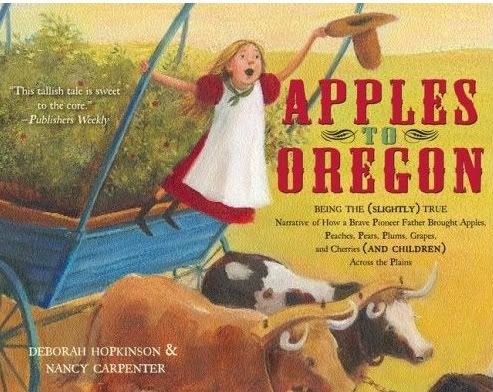
Finding water on the journey to keep the saplings alive was a huge challenge, but they succeeded in planting Oregon's first orchard in Milwaukie, about six miles south of Portland. The narrator, a spirited young'un named Delicious, relates the perils they faced, including river crossings, steep mountains, deserts, and frost, while Nancy Carpenter's oil paintings are brimming with action, fun, and just the right amount of exaggeration to keep the tension high.
Johnny Appleseed: The Legend and the Truth, by Jane Yolen, pictures by Jim Burke (HarperCollins, 2008). A beautifully executed telling of John Chapman's life, consisting of lyrical prose accentuated with poetry. Yolen carefully separates fact from fiction, in order to clarify misconceptions about this larger-than-life legend. Each stanza of an ongoing poem is paired with a prose telling of a significant milestone in Chapman's life. Jim Burke's warm, rich folk art paintings rendered in burnished earth tones invite the reader to wander back in time. Read an excellent, detailed review by Tricia at The Miss Rumphis Effect, or peek inside the book here.

The Apple King by Francesca Bosca, pictures by Giuliano Ferri, translated by J. Alison James (North-South Books, 2001). A satisfying morality tale, perfect for those who tend to be a little greedy with their apples. A rich and powerful porcine king covets his beautiful and sweet apples, not allowing anyone else in the kingdom to eat any. To his disgust and dismay, one day he discovers worms have invaded his tree. He tries everything to get rid of them, and is not successful until he learns that the tree itself has invited the worms. Muted watercolors expand the storyline in this delicious tale about sharing.
The Apple-Pip Princess by Jane Ray (Candlewick, 2007). A modern fairy tale about three princesses, who try to win their father's favor in order to inherit the crown. Since the queen's death, the land has become barren and somber, and each of the princesses has chosen one item as a remembrance of their mother. Suzanna, the eldest, chooses scarlet high heels because they make her feel tall and important. Middle sister Miranda chooses a jeweled mirror that perfectly reflects her vain self.
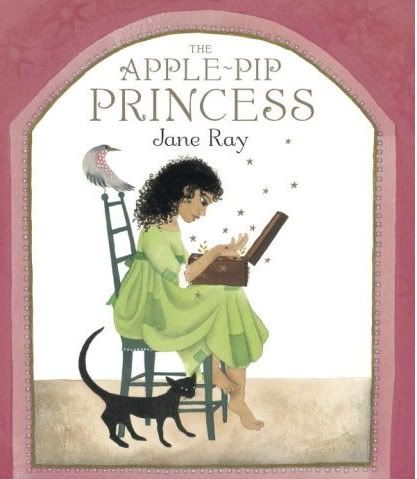
But youngest sister Serenity chooses a plain wooden box containing a single apple pip. The tallest towers built by Suzanna and Miranda pale in comparison to Serenity's achievement: she plants the apple seed, and with the help of the people, fills the kingdom once again with the beauty and fragrance of fruit and flower. A nod to cooperation, unselfishness, and the magnificent things that can come from a small idea. Ray's detailed, stylized illustrations are magical, winsome, and evocative.
The Apple Doll by Elisa Kleven (FSG, 2007). An emotionally satisfying story of shy Lizzy, who takes her homemade apple doll named Susanna with her on the first day of school. When Lizzy's teacher tells her that food and toys aren't allowed in school, Lizzy leaves Susanna at home, but she is lonely without her. Susanna soon begins to lose her freshness, so Lizzy must find a way to make her doll last forever.
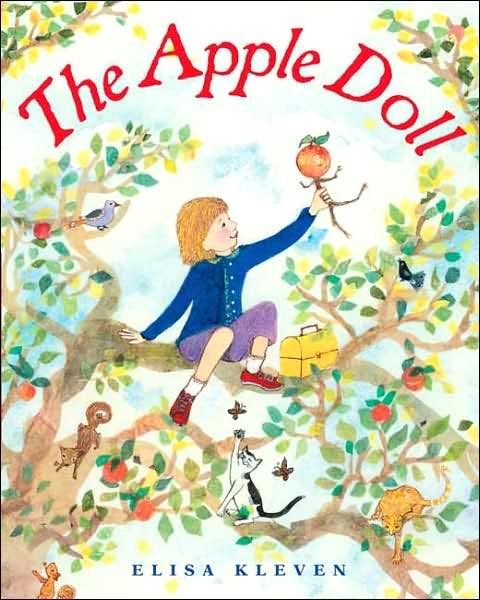
Her mother teaches her how to turn Susanna into a dried apple doll, and this newfound skill ultimately enables Lizzy to make new friends at school. A child's concerns and feelings are treated with sensitivity, and Kleven's wondrous mixed media and collage illustrations are breathtakingly beautiful. A paean on the healing power of art, with art that combines the best of color, texture, and detail. Instructions on how to make an apple doll also included. Be sure to see this book review and interview with Elisa by Jules of 7-Imp. 
Pretty pomes at Cox Farm Market, Vienna, Virginia
Have a crunchy day, my apple-cheeked friends!
Blog: jama rattigan's alphabet soup (Login to Add to MyJacketFlap)
JacketFlap tags: breakfast month, pancake picture books, thematic book lists, Add a tag
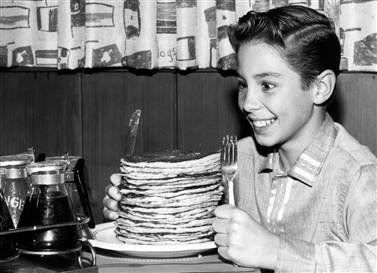
Ah, the wonder of pancakes!!
Does any other breakfast treat arouse as much unabashed joy and anticipation among diners of all ages? Whether you call them hotcakes, griddle cakes, flapjacks, flatcars, or heavenly hots, the reaction is the same. Almost every culture in the world has its own version of the pancake (crepes, blinis, galettes), and they're all special. They're also pretty ancient, dating back to Roman times.
As far as children's books, pancakes outnumber bagels, pies, and cookies. They are the perfect example of how a beloved food establishes instant reader interest and connection, reinforced by the power of sensual description.

The first pancake stories, which have a long history and dubious European origin, fall into the Aarne-Thompson 2025 folktale classification of fleeing food. Earliest recorded versions, such as "The Runaway Pancake," date back to 19th century Germany and Norway. During this same period, the gingerbread man stories became popular in America. I suppose, then, we could rightly call pancakes the first "fast food."
But I won't let them get away from you today. Here are some of my favorite pancake picture books, hot off the griddle, and guaranteed to make your kiddos, ages 4-8, flip!
1. Pancakes for Breakfast , by Tomie dePaola (Harcourt, 1978). This wordless classic never loses its charm. A woman who lives alone with her cat and dog wakes up one winter morning craving pancakes, but must gather the ingredients. She fetches eggs from the hen house, milks the cow, churns some butter, then goes out to buy some maple syrup. Upon returning, she discovers that her pets have eaten everything. No matter, the irresistible aroma of pancakes which drifts into her little house brings about a happy ending. A masterpiece of anticipation with stacks of drool-worthy pancakes.
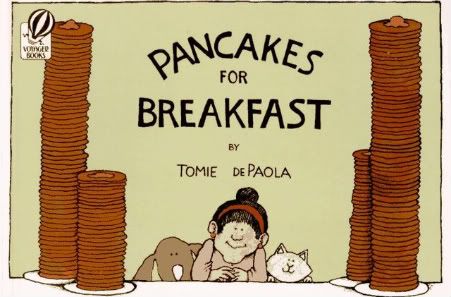
2. Curious George Makes Pancakes, based on the character created by Margret and H.A. Rey (Houghton Mifflin, 1998). Our curious monkey friend attends a charity pancake breakfast with the man in the yellow hat. While the man is off buying tickets, George's nose leads him to a long griddle dotted with fresh pancakes. Unnoticed, he decides to help by sprinkling blueberries on them. George's pancakes are a big hit, but when the cook sees him, he chases George away. The illos are adorable throughout, showing maple-syruped George getting stuck to everything, and wildly making and flipping pancakes with four limbs. With charcoal pencil and watercolor illos.
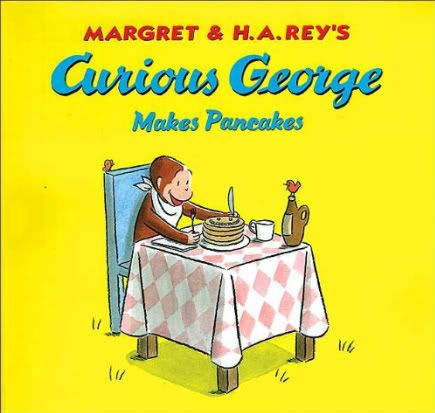
3. Pancakes, Pancakes! by Eric Carle (Simon & Schuster, 1990). Jack craves a big pancake for breakfast, and learns how to make it from scratch. From cutting and threshing wheat, grinding it into flour, to gathering eggs, milking the cow, churning butter, and fetching strawberry jam - to the actual process of combining the ingredients with his mother, young readers will certainly gain new appreciation for a food they probably take for granted in this microwave/toaster age. Carle's bright collages remain unique and fresh.
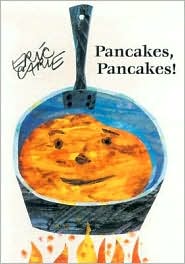

4. Hey, Pancakes! by Tamson Weston, pictures by Stephen Gammell (Harcourt, 2003). If you like your pancakes rhyming, rollicking, and rambunctious, this is the book for you. Three kids and their dog make a royal mess as they stir up some boisterous batter. Pancakes flip and fly through pages full of splatters and splots. Kids will no doubt love the short, catchy rhyme and beg you to make the recipe for Grandma's Pancakes included in the book. Gammell's mixed media illos create the perfect high pitched frenzy that celebrates the pure, unadulterated joy of pancakes.
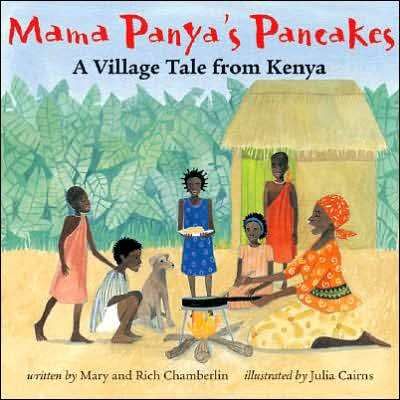
5. Mama Panya's Pancakes: A Village Tale from Kenya, by Mary and Rich Chamberlin, pictures by Julia Cairns (Barefoot Books, 2005). On the way to market, Adika and his mother meet many friends who live in various parts of their rural village. Happily anticipating a pancake supper that evening, Adika simply can't resist inviting everyone to share their meal. Mama Panya is worried that she won't be able to feed so many people, but Adika keeps telling her that she has "a little bit, and a little bit more," and that will be enough. This handsome book contains a list of Kiswahili greetings, map of Kenya, glossary of the plants and animals Adika and his mother encounter on their journey, info about village life in Kenya, and of course, Mama Panya's recipe for spicy pancakes. Julia Cairns' beautiful and engaging watercolor illos enrich this story about the rewards of giving what little you have.
 I've flipped for you!
I've flipped for you!


